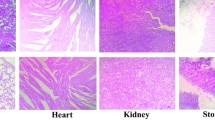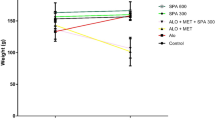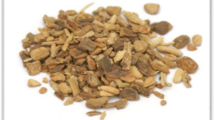Abstract
Efficacy of several plant extracts in the clinical research for modulating oxidative stress correlated with diabetes mellitus (DM) is well documented. In the present study, we investigated the in vitro antioxidant activity, toxicity, and anti-diabetic activity of methanolic extract of Hippophae salicifolia leaves in normal and alloxan-induced diabetic wistar rats. H. salicifolia leaves were found to be rich in antioxidants. The acute toxicity test of methanolic extract of H. salicifolia leaves revealed that the median lethal dose (LD50) was found to be 3.92 g/kg body weight in mice. Administration of H. salicifolia leaves at 200 mg/kg and 400 mg/kg in alloxan-induced diabetic rats illustrated significant reduction (22% and 39%, respectively) in fasting blood glucose compared to diabetic control. Both the doses were found to be effective when compared to diabetic rats. The Hippophae-treated diabetic rats showed significant increase in the endogenous antioxidant enzymes, superoxide dismutase (50% and 74%, respectively), glutathione peroxidase (57% and 41%, respectively) and decrease in malondialdehyde (33% and 15%, respectively) levels. These results suggested that the methanolic leaf extract of H. salicifolia enhanced the antioxidant defence against reactive oxygen species produced under hyperglycaemic conditions.



Similar content being viewed by others
References
Ahmed D, Kumar V, Verma A, Gupta PS, Kumar H, Dhingra V, Mishra V, Sharma M (2014) Anti-diabetic, renal/hepatic/pancreas/cardiac protective and antioxidant potential of methanol/dichloromethane extract of Albizzia Lebbeck Benth. stem bark (ALEx) on streptozotocin induced diabetic rats. BMC Complement Altern Med 14:243
American Diabetes Association (2014) Diagnosis and classification of diabetes mellitus. Diabetes Care 37(Suppl 1):S81–S90
Arimboor R, Kumar KS, Arumughan C (2008) Simultaneous estimation of phenolic acids in sea buckthorn (Hippophaë rhamnoides) using RP-HPLC with DAD. J. Pharm. Biomed. Anal. 47(1):31–38
Asgary S, Rahimi P, Mahzouni P, Madani H (2012) Antidiabetic effect of hydroalcoholic extract of Carthamus tinctorius L. in alloxan-induced diabetic rats. J Res Med Sci 17(4):386–392
Bazargani YT, de Boer A, Leufkens HGM, Mantel-Teeuwisse AK (2014) Selection of essential medicines for diabetes in low and middle income countries: a survey of 32 national essential medicines lists. PLoS ONE 9(9):e106072
Cao QH, Qu WJ, Deng YX, Zhang ZC, Niu W, Pan YF (2003) Effects of flavonoids from the seed and fruit residue of Hippophae rhamnoides L. on glycometabolism in mice. J Chin Med Mater 26:735–737
Chang CLT, Lin Y, Bartolome AP, Chen YC, Chiu SC, Yang WC (2013) Herbal therapies for type 2 diabetes mellitus: chemistry, biology, and potential application of selected plants and compounds. Evid-Based Complement Altern Med 2013:378657
Choubey S, Varughese LR, Kumar V, Beniwal V (2015) Medicinal importance of gallic acid and its ester derivatives: a patent review. Pharm Pat Anal 4(4):305–315
Conlee KM, Stephens ML, Rowan AN, King LA (2005) Carbon dioxide for euthanasia: concerns regarding pain and distress, with special reference to mice and rats. Lab. Anim. 39:137–161
Dardano A, Penno G, Del Prato S, Miccoli R (2014) Optimal therapy of type 2 diabetes: a controversial challenge. Aging (Albany NY) 6(3):187–206
Dey SK, Middha SK, Usha T, Brahma BK, Goyal AK (2018) Antidiabetic activity of giant grass Bambusa tulda. Bangladesh J Pharmacol 13(2):134–136
Flohe L, Gunzler WA (1984) Assays of glutathione peroxidase. Method Enzymol 105:114–121
Foti MC (2007) Antioxidant properties of phenols. J. Pharm. Pharmacol. 59(12):1673–1685
Geetha S, Ram MS, Mongia SS, Singh V, Ilavazhagan G, Sawhney RC (2003) Evaluation of antioxidant activity of leaf extract of Seabuckthorn (Hippophae rhamnoides L.) on chromium (VI) induced oxidative stress in albino rats. J. Ethnopharmacol. 87:247–251
Goyal AK, Middha SK, Sen A (2010) Evaluation of the DPPH radical scavenging activity, total phenols and antioxidant activities in Indian wild Bambusa vulgaris “Vittata” methanolic leaf extract. J Nat Pharm 1(1):40–45
Goyal AK, Basistha BC, Sen A, Middha SK (2011) Antioxidant profiling of Hippophae salicifolia growing in sacred forests of Sikkim, India. Funct. Plant Biol. 38:697–701
Goyal AK, Mishra T, Bhattacharya M, Kar P, Sen A (2013) Evaluation of phytochemical constituents and antioxidant activity of selected actinorhizal fruits growing in the forests of North-East India. J. Biosci. 38(4):797–803
Goyal AK, Middha SK, Usha T, Sen A (2017) Analysis of toxic, antidiabetic and antioxidant potential of Bambusa balcooa Roxb leaf extracts in alloxan-induced diabetic rats. 3 Biotech 7(2):120
Guariguata L, Whiting DR, Hambleton I, Beagley J, Linnenkamp U, Shaw JE (2014) Global estimates of diabetes prevalence for 2013 and projection for 2035. Diabetes Res. Clin. Pract. 103(2):137–149
Guliyev VB, Gul M, Yildirim A (2004) Hippophae rhamnoides L.:chromatographic methods to determine chemical composition, use in traditional medicine and pharmacological effects. J. Chromatogr. B 812:291–307
Kharroubi AT, Darwish HM (2015) Diabetes mellitus: the epidemic of the century. World J Diabetes 6(6):850–867
King H, Aubert R, Herman W (1998) Global burden of diabetes, 1995-2025, prevalence, numerical estimates and projections. Diabetes Care 21:1414–1431
Loomis TA, Hayes AW (1996) Loomis’s essentials of toxicology. Academic press, California, pp 208–245
Mazzari ALDA, Prieto JM (2014) Herbal medicines in Brazil: pharmacokinetic profile and potential herb-drug interactions. Front Pharmacol 5:162
McLellan KCP, Wyne K, Villagomez ET, Hsueh WA (2014) Therapeutic interventions to reduce the risk of progression from prediabetes to type 2 diabetes mellitus. Ther. Clin. Risk Manag. 10:173–188
Middha SK, Bhattacharjee B, Saini D, Baliga MS, Nagaveni MB, Usha T (2011) Protective role of Trigonella foenum graceum extract against oxidative stress in hyperglycemic rats. Eur Rev Med Pharmacol Sci 15(4):427–435
Middha SK, Usha T, Ravikiran T (2012) Influence of Punica granatum L. on region specific responses in rat brain during alloxan-induced diabetes. Asian Pac J Trop Biomed 2:S905–S909
Middha SK, Goyal AK, Faizan SA, Sanghamitra N, Basistha BC, Usha T (2013) In silico–based combinatorial pharmacophore modelling and docking studies of GSK-3β and GK inhibitors of Hippophae. J. Biosci. 38(4):805–814
Middha SK, Goyal AK, Lokesh P, Yardi V, Mojamdar L, Keni DS, Babu D, Usha T (2015) Toxicological evaluation of Emblica officinalis fruit extract and its anti-inflammatory and free radical scavenging properties. Pharmacogn Mag 11:427–433
Middha SK, Usha T, Pande V (2016) Insights into the causes and anti-hyperglycemic effects of Punica granatum rind in alloxan-induced diabetic rats. Chiang Mai J Sci 43:112–122
Misra HP, Fridovich I (1972) The role of superoxide anion in the auto-oxidation of epinephrine and a simple assay for superoxide dismutase. J. Biol. Chem. 247:3170–3175
Ohkawa H, Ohishi N, Yagi K (1979) Assay of lipid peroxides in animal tissues by thiobarbituric acid reaction. Anal. Biochem. 95:351–358
Parmar HS, Kar A (2007) Antidiabetic potential of Citrus sinensis and Punica granatum peel extracts in alloxan treated male mice. BioFactors 31:17–24
Perumal SR, Ponnampalam G (2007) current status of herbal and their future perspectives. Nature Preced 10101(1176):1
Raj J, Chnadra M, Dogra TD, Pahuja M, Raina A (2013) Determination of median lethal dose of combination of Endosulfan and Cypermethrin in Wistar rat. Toxicol Int 20(1):1–5
Ramu S, Krishnaraj K, Devika A, Murali A (2014) Protective effects of Hippophae salicifolia D. Don fruit pulp extract in aluminium toxicity. Spatula DD 4(4):207–212
Rawat S, Kumar N, Kothiyal P (2013) Evaluate the anti-diabetic activity of Myrica esculenta in streptozotocin induced rats. Int J Univ Pharm Bio Sci 2(6):510–525
Saikia M, Handique PJ (2013) Antioxidant and antibacterial activity of leaf, bark, pulp and seed extracts of seabuckthorn (Hippophae salicifolia D. Don) of Sikkim Himalayas. J Med Plants Res 7(19):1330–1338
Shah NA, Khan MR (2014) Antidiabetic Effect of Sida cordata in alloxan induced diabetic rats. Biomed. Res. Int. 2014:671294
Sharma M, Siddique MW, Shamim AM, Gyanesh S, Pillai KK (2011) Evaluation of antidiabetic and antioxidant effects of seabuckthorn (Hippophae rhamnoides L.) in streptozotocin-nicotinamide induced diabetic rats. Open Conf Proc J 2:53–58
Singleton VL, Rossi JA (1965) Colorimetry of total phenolics with phosphomolybdic-phosphotungstic acid reagents. Am. J. Enol. Vitic. 16:144–158
Sun JE, Ao ZH, Lu ZM, Xu HY, Zhang XM, Dou WF, Xu ZH (2008) Antihyperglycemic and antilipidperoxidative e ffects of dry matter of culture broth of Inonotus obliquus in submerged culture on normal and alloxan-diabetes mice. J. Ethnopharmacol. 118:7–13
Usha T, Middha SK, Goyal AK, Karthik M, Manoj D, Faizan S, Goyal P, Prashanth HP, Pande V (2014) Molecular docking studies of anti-cancerous candidates in Hippophae rhamnoides and Hippophae salicifolia. J Biomed Res 28(5):406–415
Usha T, Middha SK, Narzary D, Brahma BK, Goyal AK (2017) In silico and in vivo based scientific evaluation of traditional anti-diabetic herb Hodgsonia heteroclita. Bangladesh J Pharmacol 12(2):165–166
Wang B, Lin L, Ni Q, Su CL (2011) Hippophae rhamnoides Linn. for treatment of diabetes mellitus: a review. J Med Plant Res 5(13):2599–2607
Zharikova OL, Fokina VM, Nanovskaya TN, Hill RA, Mattison DR, Hankins GD, Ahmed MS (2009) Identification of the major human hepatic and placental enzymes responsible for the biotransformation of glyburide. Biochem. Pharmacol. 78(12):1483–1490
Zheng X, Long W, Liu G, Zhang X, Yang X (2012) Effect of seabuckthorn (Hippophae rhamnoides ssp. sinensis) leaf extract on the swimming endurance and exhaustive exercise-induced oxidative stress of rats. J. Sci. Food Agric. 92:736–742
Acknowledgements
Authors are grateful to Biotechnology-Skill Enhancement program, under Govt. of Karnataka at Maharani Lakshmi Ammanni College for Women, for funding animal house facility to carry out this study.
Author information
Authors and Affiliations
Contributions
TU and AKG performed the experiments, analyzed the data and prepared the manuscript. BCB procured and prepared the sample and wrote a part of the manuscript. SKM conceived the idea, designed and coordinated the experiments, improved the manuscript.
Corresponding author
Ethics declarations
Conflict of interest
The authors declare that there are no conflicts of interest.
Ethical approval
All applicable international, national, and/or institutional guidelines for the care and use of animals were followed. All procedures performed in the studies involving animals were in accordance with the ethical standards of the institution or practice at which the studies were conducted.
Electronic supplementary material
Below is the link to the electronic supplementary material.

Rights and permissions
About this article
Cite this article
Middha, S.K., Usha, T., Basistha, B.C. et al. Amelioration of antioxidant potential, toxicity, and antihyperglycemic activity of Hippophae salicifolia D. Don leaf extracts in alloxan-induced diabetic rats. 3 Biotech 9, 308 (2019). https://doi.org/10.1007/s13205-019-1840-3
Received:
Accepted:
Published:
DOI: https://doi.org/10.1007/s13205-019-1840-3




